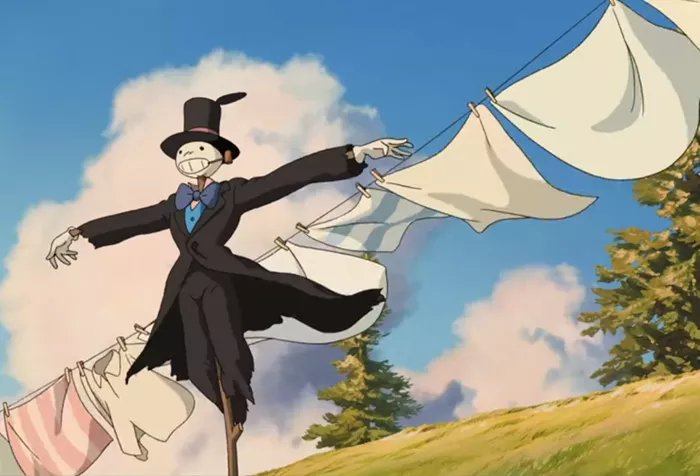“Howl’s Moving Castle,” directed by Hayao Miyazaki and based on the novel by Diana Wynne Jones, is a beloved animated film known for its rich storytelling, magical themes, and memorable characters. Among these characters is the mysterious Scarecrow, who plays a significant role in the narrative. This article delves into the identity, significance, and deeper meaning of the Scarecrow in “Howl’s Moving Castle”.
Howl’s Moving Castle
Before exploring the Scarecrow’s role, it’s essential to understand the world of “Howl’s Moving Castle.” Set in a fantastical realm where magic is commonplace, the story follows a young woman named Sophie who is cursed by a witch and transformed into an old woman. In her quest to break the curse, Sophie encounters the enigmatic wizard Howl and his magical moving castle, embarking on a journey of self-discovery, love, and courage.
The Scarecrow: A Mysterious Figure
Introduction and Appearance
The Scarecrow first appears early in the film, standing alone in a desolate landscape. Unlike traditional scarecrows, this figure exudes a haunting aura, with a melancholic expression and tattered clothing. Its straw-filled form suggests it was once meant to guard fields, yet its presence transcends mere agricultural duty.
Interaction with Sophie
Sophie, in her elderly form, encounters the Scarecrow during her journey. Despite its immobility and seemingly inert state, the Scarecrow communicates with Sophie in a subtle, almost telepathic manner. This interaction sets in motion a series of events that reveal the Scarecrow’s true nature and significance.
Unraveling the Mystery: What is the Scarecrow?
Symbolism and Metaphor
In “Howl’s Moving Castle,” the Scarecrow serves as a powerful symbol of lost identity, longing, and redemption. Its transformation from a simple agricultural tool into a sentient being mirrors Sophie’s own journey of transformation and self-discovery. Through the Scarecrow, the film explores themes of loneliness, purpose, and the search for meaning in a magical world.
Echoes of Literature and Folklore
The concept of a sentient scarecrow draws upon literary and folkloric traditions. In many cultures, scarecrows are imbued with symbolic significance beyond their practical role in farming. They can represent guardianship, the passage of seasons, and the boundary between the human world and the natural realm. Miyazaki’s interpretation enriches this archetype with emotional depth and narrative complexity.
The Scarecrow’s Role in Sophie’s Journey
Catalyst for Change
The Scarecrow’s presence catalyzes significant developments in Sophie’s personal growth. Through their encounters, Sophie gains insight into her own feelings of displacement and uncertainty. The Scarecrow becomes a confidant of sorts, offering silent companionship and prompting introspection.
See Also: How Strong Is Ash Ketchum?
A Mirror for Sophie
In many ways, the Scarecrow acts as a mirror for Sophie’s emotional journey. Both characters grapple with feelings of isolation and estrangement from their true selves. Sophie’s interactions with the Scarecrow help her confront these inner conflicts and embrace her newfound resilience and empathy.
Themes Explored Through the Scarecrow
Loneliness and Connection
Central to the Scarecrow’s story is the theme of loneliness. As a discarded figure in a barren landscape, it embodies the longing for connection and understanding. Through Sophie’s empathy and Howl’s compassion, the Scarecrow finds solace and purpose, highlighting the transformative power of human connection.
Identity and Transformation
The Scarecrow’s transformation from a static figure to a sentient being parallels Sophie’s own journey of transformation. Both characters undergo profound changes, shedding their initial limitations and embracing newfound strengths. This theme underscores the film’s exploration of identity and the fluidity of self-perception.
Interpretations and Symbolic Meanings
Environmental Allegory
Some interpretations view the Scarecrow as an allegory for environmental stewardship. Its role as a guardian of fields speaks to humanity’s relationship with nature and the consequences of neglect. By imbuing the Scarecrow with sentience, Miyazaki prompts reflection on ecological responsibility and the interconnectedness of all living beings.
Existential Reflection
At its core, the Scarecrow’s narrative invites existential reflection. Its existence prompts questions about purpose, mortality, and the quest for meaning in a chaotic world. Through its interactions with Sophie and other characters, the Scarecrow encourages viewers to contemplate their own journeys of self-discovery and personal growth.
Conclusion: The Scarecrow’s Legacy
In “Howl’s Moving Castle,” the Scarecrow transcends its origins as a simple scarecrow to become a poignant symbol of resilience, empathy, and the search for identity. Through its interactions with Sophie and the film’s other characters, the Scarecrow enriches the narrative with themes of loneliness, transformation, and the interconnectedness of all beings. Its story resonates as a testament to the power of empathy and the enduring quest for meaning in a world touched by magic and mystery.
By exploring the Scarecrow’s role in “Howl’s Moving Castle,” viewers gain deeper insight into the film’s thematic richness and Miyazaki’s storytelling prowess. As a character both haunting and hopeful, the Scarecrow leaves an indelible impression, inviting contemplation long after the credits roll.

